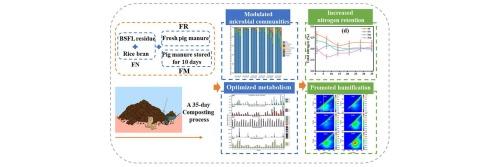微生物机制促进黑兵飞草与猪粪共堆肥腐殖质化和氮保持。
IF 7.1
2区 环境科学与生态学
Q1 ENGINEERING, ENVIRONMENTAL
引用次数: 0
摘要
近年来,黑虻幼虫对食物垃圾的生物转化引起了越来越多的关注。然而,收获幼虫后产生的营养丰富的BSFL草不符合有机肥标准,需要二次堆肥。本研究以新鲜猪粪(FR)和贮存10 d (FM)两种不同类型的猪粪(BSFL)为原料,研究了以米糠为填充剂促进腐殖质化和氮保持的微生物机制。结果表明,FM的耐热期最长,超过50℃15 d,超过55℃8 d,萌发指数最高(64.41±2.13%),含氮量最高(4.09±0.21%)。紫外-可见(UV-Vis)光谱结果表明,FM促进了最有效的腐殖化过程,三维荧光光谱仪(3D-EEM)分析证实了更大的腐植酸形成。微生物分析显示了主要的细菌演替,关键种群包括芽孢杆菌、微球菌、Saccharomonospora和未培养的鞘菌科。基于PICRUSt2分析的功能预测表明,氮的同化和固定增强,而反硝化抑制,从而最大限度地减少氮的损失。本研究为将昆虫生物转化与畜禽粪便堆肥相结合,实现高价值有机废物的循环利用提供了可行的策略。本文章由计算机程序翻译,如有差异,请以英文原文为准。

Microbial mechanisms enhancing humification and nitrogen retention during co-composting of black soldier fly frass and pig manure
The bioconversion of food waste by black soldier fly larvae (BSFL) has garnered increased attention in recent years. However, nutrient-rich BSFL frass produced after larval harvesting does not meet the standard for organic fertilizer and requires secondary composting. This study investigated the co-composting of BSFL frass with different types of pig manure, including fresh (FR) and stored for 10 days (FM), to explore the microbial mechanisms enhancing humification and nitrogen retention using rice bran as a bulking agent. Results indicated FM achieved the longest thermophilic phase, exceeding 50 °C for 15 days and 55 °C for 8 days, along with the highest germination index (64.41 ± 2.13 %) and nitrogen content (4.09 ± 0.21 %). Ultraviolet–visible (UV–Vis) spectroscopy results demonstrated that FM facilitated the most effective humification process, with three-dimensional fluorescence spectrometer (3D-EEM) analyses confirming a greater humic acid formation. Microbial profiling revealed a predominant bacterial succession, with key populations including Bacillus spp., Micrococcales, Saccharomonospora, and uncultured Sphingobacteriaceae. Functional predictions based on PICRUSt2 analysis indicated nitrogen assimilation and fixation were enhanced, while denitrification was suppressed, thereby minimizing nitrogen loss. This study provides a viable strategy for integrating insect-based bioconversion with livestock manure composting to achieve high-value organic waste recycling.
求助全文
通过发布文献求助,成功后即可免费获取论文全文。
去求助
来源期刊

Waste management
环境科学-工程:环境
CiteScore
15.60
自引率
6.20%
发文量
492
审稿时长
39 days
期刊介绍:
Waste Management is devoted to the presentation and discussion of information on solid wastes,it covers the entire lifecycle of solid. wastes.
Scope:
Addresses solid wastes in both industrialized and economically developing countries
Covers various types of solid wastes, including:
Municipal (e.g., residential, institutional, commercial, light industrial)
Agricultural
Special (e.g., C and D, healthcare, household hazardous wastes, sewage sludge)
 求助内容:
求助内容: 应助结果提醒方式:
应助结果提醒方式:


